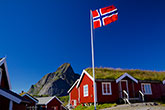Gate terminal to add LNG break bulk infrastructure
Published by Callum O'Reilly,
Senior Editor
LNG Industry,
The Gate terminal has taken the final investment decision to add LNG break bulk infrastructure and services to the terminal, which is a joint venture between Gasunie and Royal Vopak.
The new facility in the port of Rotterdam is expected to boost the use of LNG as a transportation fuel in the Netherlands and Northwest Europe.
The Port of Rotterdam Authority is involved in this project with the design and construction of a dedicated harbour basin for LNG break bulk operations and has already introduced new regulations that allow LNG bunkering for inland barges and ship-to-ship bunkering of seagoing vessels.
The commissioning and commencement of the first services of this new LNG infrastructure for tanker barges and other small tankers are scheduled for the first half of 2016. By then, a whole supply chain for LNG will be available in the port of Rotterdam.
Shell has been announced as the launching customer, and the company will play a key role in enabling the project, which creates the conditions for the use of LNG as a transportation fuel to take off in Northern Europe. From Gate in Rotterdam, it will be possible for customers such as Shell to supply LNG to bunker stations in the Wadden area, Scandinavia and the Baltics, as well as to stations along the Rhine, Main and Danube.
The new infrastructure at Gate terminal will also represent an important step in achieving the goals of the ‘Green Deal Rhine and Wadden’. This partnership between the Dutch government, business and knowledge institutes aims to promote green growth. With its extended break bulk facilities, Gate terminal will be at the basis of cleaner transport by road, inland waterways and coastal shipping throughout Northern Europe. Surveys indicate that the introduction of LNG as a transport fuel could bring considerable economic growth and employment.
The project is key to facilitate LNG storage and to secure LNG supply in Northwest European ports, such as Gothenburg. The maritime connection between Rotterdam and this area is regarded as a part of the EU ‘motorways of the sea’ concept and has therefore been selected for co-financing under the European Union's TEN-T programme.
Small scale LNG
Small scale services aim to split up large scale LNG shipments into smaller quantities, thus enabling the distribution of LNG as a fuel for maritime vessels, ferries, trucks and industrial applications.
The use of LNG as a fuel is expected to grow substantially following the introduction of stringent new emission regulations (SECA) for the marine sector in the North Sea and in the Baltic Sea from 2015. By using LNG as a fuel, barges, coasters, ferries, as well as heavy trucks, can reduce their CO2 emissions by up to 20%, their NOx emissions by up to 85%, while also reducing sulfur and particle emissions to almost zero.
The Dutch government and the EU are encouraging the development of LNG as a transportation fuel.
LNG hub
The Gate terminal contributes to diversifying the European gas supply by providing access to LNG originating from countries around the world. The LNG is received, stored, regasified and then fed into the Northwest-European gas grid.
In January 2014, Gate launched a tank truck loading station for trucks and containers, with a total capacity of 5000 trucks per year. Over the past year, Gate has also developed into a hub, from where LNG can be re-exported to other parts of Europe and around the world.
Adapted from press release by Callum O'Reilly
Read the article online at: https://www.lngindustry.com/lng-shipping/03072014/gate_terminal_to_add_lng_break_bulk_infrastructure_908/
You might also like
Gasum opens new biogas filling station in Norway
Gasum has opened its ninth bio-LNG station in Norway, located in Førde.


